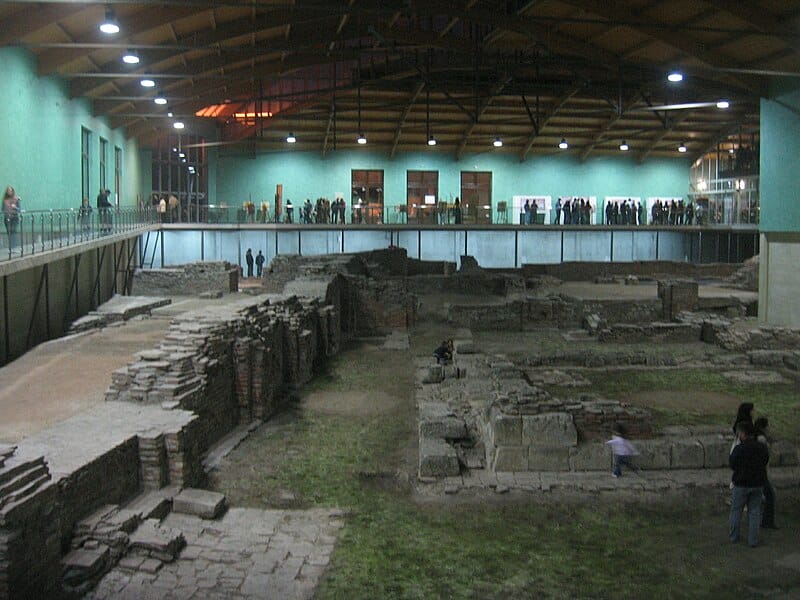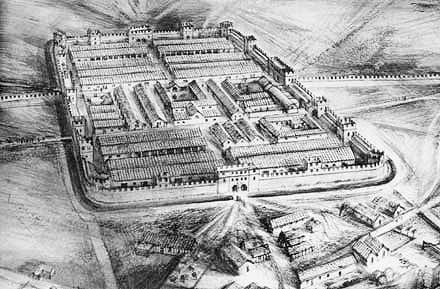Archaeologists in Serbia have unearthed a Roman triumphal arch that dates back to the early 3rd century. The discovery was made during excavations around the city of Viminacium, which is now known as Zajecar. This ancient city was an important military center in the region, and the arch is believed to have been built to commemorate the victories of a Roman emperor.
The arch is made of white marble and stands at a height of 4 meters. It is decorated with intricate carvings and reliefs that depict scenes from the life of the emperor, as well as battles and other important events from Roman history. The arch is considered to be one of the most important archaeological finds in Serbia in recent years, and it has attracted the attention of scholars and historians from around the world.
The discovery of the arch sheds new light on the history of Sirmium and the Roman Empire in the region. It is a testament to the power and influence of the Roman Empire in the Balkans, and it provides valuable insights into the culture and society of the time. The excavation of the arch is ongoing, and archaeologists are hopeful that further discoveries will be made in the coming weeks and months.
Discovery of the Triumphal Arch
The discovery of a Roman triumphal arch in Serbia has caused a stir in the archaeological community. The arch was unearthed during excavations in the town of Zaječar, in the east of the country. It is believed to have been built in the third century AD, during the reign of Emperor Galerius. The arch was found at the site of the ancient Roman city of Viminacium.
The initial excavation findings revealed that the triumphal arch is made of stone and is decorated with reliefs depicting scenes from the life of Emperor Galerius. The arch is believed to have been built to commemorate his military victories in the Balkans. The arch is 12 meters high, 18 meters wide, and 3 meters deep.
The arch is in remarkable condition considering its age. The reliefs are well-preserved, and the inscription on the arch is still legible. The discovery of the arch is significant as it sheds light on the history of the Roman Empire in the Balkans. The arch is now being studied by archaeologists, who hope to learn more about its construction and the history of the region during the Roman era.
Historical Significance
The recent discovery of a Roman triumphal arch in Serbia has significant historical importance. The arch was unearthed during a construction project, and it is believed to date back to the 3rd century AD.
Roman architecture was known for its grandeur and extravagance, and the discovery of this arch is a testament to the Roman Empire’s influence in the region. Triumphal arches were typically built to commemorate military victories and were often decorated with intricate carvings and sculptures. The arch in Sremska Mitrovica is no exception, as it features detailed reliefs depicting Roman soldiers and mythological figures. This discovery is a significant contribution to our understanding of Roman architecture and its impact on the culture and history of Serbia.
Architectural Features
The recently discovered Roman triumphal arch in Serbia is a remarkable example of ancient Roman architecture. The arch stands at a height of 11 meters and is made of white marble. It is adorned with intricate designs, inscriptions, and reliefs that provide a glimpse into the Roman Empire’s culture and traditions.
The arch’s design is typical of Roman triumphal arches, with a central archway flanked by two smaller arches. The archway is decorated with Corinthian columns, and the arch’s spandrels are adorned with intricate carvings of mythological creatures and Roman gods. The central archway is topped with a pediment, which is decorated with a relief of a quadriga, a chariot drawn by four horses.

The arch’s symbolism is also typical of Roman triumphal arches. It was built to commemorate a military victory, likely by the Roman Emperor Galerius. The arch’s reliefs depict scenes from the military campaign, including soldiers, weapons, and prisoners of war. The arch’s inscriptions honor Galerius and his achievements, proclaiming him as a conqueror and a savior of the Roman Empire.
Inscriptions and Reliefs
The arch’s inscriptions and reliefs provide valuable historical information about the Roman Empire’s military campaigns and its political and cultural values. The inscriptions are written in Latin and Greek and provide details about Galerius’s military achievements and his role in the Roman Empire’s political and social hierarchy. The reliefs depict scenes from Galerius’s military campaign, including battles, sieges, and triumphal processions. They also depict scenes from Roman mythology, such as the Labours of Hercules and the Triumph of Bacchus. The reliefs are highly detailed and provide a vivid depiction of Roman military life and culture.

Preservation and Restoration
Upon the discovery of the Roman triumphal arch in Serbia, extensive conservation efforts were undertaken to preserve the historical artifact. The arch was in a state of disrepair and required significant restoration work to ensure its longevity.
The restoration process involved a team of experts who used a combination of traditional and modern techniques to restore the arch. The team carefully removed the layers of dirt and grime that had accumulated on the arch over the centuries. They also repaired any damage to the arch, including cracks and missing pieces. To prevent further damage, the arch was treated with a special coating that protects it from the elements. The coating also helps to prevent corrosion and deterioration.
Public Access and Display
After the restoration process was complete, the Roman triumphal arch was made accessible to the public. It is now on display in Serbia, where visitors can view it up close and learn about its historical significance. The arch is displayed in a specially designed exhibit that highlights its unique features and provides information about its history. The exhibit includes interactive displays, videos, and other multimedia elements that help visitors understand the importance of the arch.
To ensure the arch remains in good condition, the museum has implemented strict guidelines for visitors. These guidelines include restrictions on touching the arch and limits on the number of visitors allowed in the exhibit at one time. The preservation and restoration efforts have ensured that the Roman triumphal arch will remain a valuable historical artifact for generations to come.
Future Research
The discovery of the Roman triumphal arch in Serbia has generated significant academic interest in the field of archaeology. The arch provides a glimpse into the Roman Empire’s presence in the region and sheds light on the architecture and design of Roman monuments. Researchers are eager to explore the arch’s historical context and its significance in the broader context of the Roman Empire.
The arch’s inscriptions and reliefs offer valuable insights into the cultural and political climate of the time. Scholars will likely analyze the arch’s iconography and symbolism to gain a better understanding of the Roman Empire’s propaganda and messaging strategies. Additionally, the arch may provide clues about the relationship between the Roman Empire and the local population and their respective cultural influences on each other.
Potential for Further Discoveries
This discovery has also raised the possibility of further archaeological discoveries in the region. The arch’s location suggests that there may be additional Roman ruins in the area waiting to be unearthed. Researchers will likely conduct surveys and excavations in the surrounding area to explore the possibility of other significant finds.
It also highlights the importance of preserving and protecting archaeological sites. The arch’s well-preserved state is a testament to the efforts of those who have worked to protect it over the centuries. Researchers and policymakers must work together to ensure that other archaeological sites are similarly protected and preserved for future generations to study and enjoy.
People Also Ask:
What is the historical significance of Roman triumphal arches?
Roman triumphal arches were built to commemorate military victories and to honor victorious generals and emperors. These arches were often used as a propaganda tool to showcase the power and might of the Roman Empire. They were also used as a symbol of Roman triumph and victory.
How did the discovery of a Roman triumphal arch in Serbia contribute to our understanding of Roman architecture?
The discovery of a Roman triumphal arch in Serbia has contributed greatly to our understanding of Roman architecture. It has provided archaeologists with valuable information about the architectural style and techniques used by the Romans. The arch also provides insight into the cultural and political climate of the time period in which it was built.
Can you list notable examples of Roman triumphal arches found in Europe?
Some notable examples of Roman triumphal arches found in Europe include the Arch of Titus in Rome, the Arch of Constantine in Rome, and the Arch of Septimius Severus in Rome. Other examples can be found in France, Spain, and other parts of Italy.
What were the common architectural features of Roman triumphal arches?
Roman triumphal arches typically had three archways, with the central arch being larger than the two side arches. They were often decorated with reliefs depicting military victories and conquests. The arches were made of stone and were typically adorned with columns and other decorative elements.
How are Roman triumphal arches typically dated and authenticated by archaeologists?
Roman triumphal arches are typically dated and authenticated by analyzing the architectural style, materials used, and inscriptions found on the arch. Carbon dating and other scientific techniques can also be used to determine the age of the arch.
What impact did the Roman Empire have on the architectural heritage of Serbia?
The Roman Empire had a significant impact on the architectural heritage of Serbia. The discovery of the Roman triumphal arch in Serbia is evidence of the Roman influence on the region. The Romans built many structures in Serbia, including roads, aqueducts, and fortifications. These structures have left a lasting impact on the region’s architectural heritage.
Hello, my name is Vladimir, and I am a part of the Roman-empire writing team.
I am a historian, and history is an integral part of my life.
To be honest, while I was in school, I didn’t like history so how did I end up studying it? Well, for that, I have to thank history-based strategy PC games. Thank you so much, Europa Universalis IV, and thank you, Medieval Total War.
Since games made me fall in love with history, I completed bachelor studies at Filozofski Fakultet Niš, a part of the University of Niš. My bachelor’s thesis was about Julis Caesar. Soon, I completed my master’s studies at the same university.
For years now, I have been working as a teacher in a local elementary school, but my passion for writing isn’t fulfilled, so I decided to pursue that ambition online. There were a few gigs, but most of them were not history-related.
Then I stumbled upon roman-empire.com, and now I am a part of something bigger. No, I am not a part of the ancient Roman Empire but of a creative writing team where I have the freedom to write about whatever I want. Yes, even about Star Wars. Stay tuned for that.
Anyway, I am better at writing about Rome than writing about me. But if you would like to contact me for any reason, you can do it at [email protected]. Except for negative reviews, of course. 😀
Kind regards,
Vladimir
